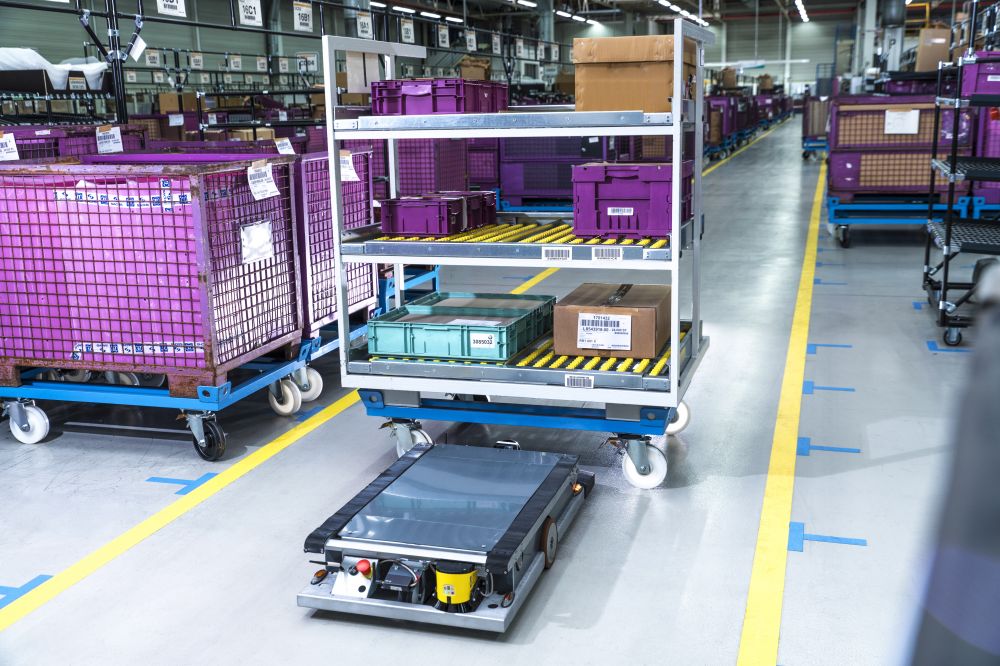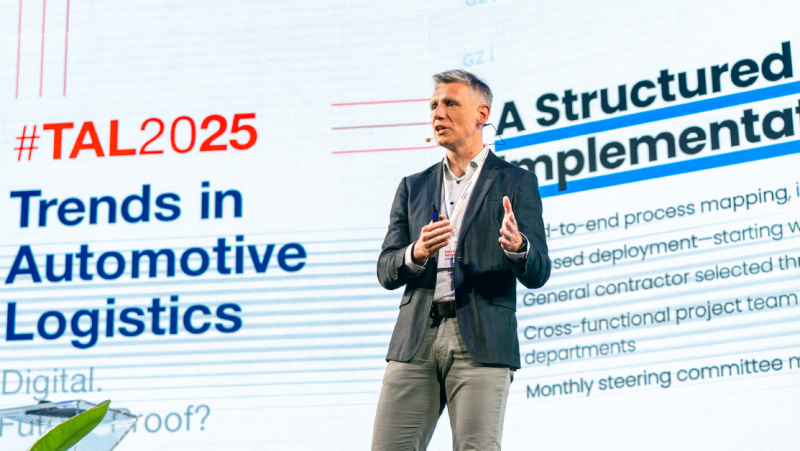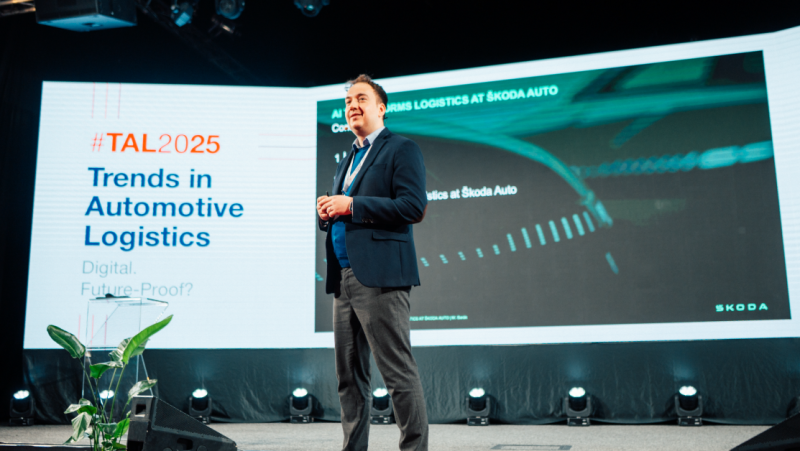What Makes Smart Logistics Smart? An Interview With Marco Prüglmeier From BMW Group
- Trends
- Interview
When it comes to digitalization in logistics and manufacturing, the question most often asked is what will happen to the human workers. Will they be made redundant? The very clear answer is “no”. Digitalization is nothing without human workers. It is there to support them, not to replace them.
This is, in a nutshell, what Marco Prüglmeier, Project Leader Innovation and Industry 4.0 Logistics at BMW Group, explained in a Q&A after his keynote at our Trends in Automotive Logistics 2020 conference, which took place in February. Marco can speak with some authority on this topic. He and his team were awarded the German Logistics Prize 2019 for the project Logistics Next. Their objective was to build agile and smart inbound and transport logistics to be able to react fast and smooth to evolving logistics processes.
A very popular output of Logistics Next are the Smart Transport Robots (STRs). Can you tell us more about these robots?
We developed this vehicle, the Smart Transport Robots, ourselves. There was nothing else on the market that met our requirements. The robots have built-in technology that you can find in actual BMW cars. One of our objectives was to use our own technology within our logistics vehicles.
We also had some further specifications that could not be fulfilled by any vendor. One of them is the height: the vehicle needs to be 22 cm high, so it can fit underneath our roller stillages.
We worked for over four years on industrializing these robots and have an overall equipment efficiency of 97%. So, our system is very robust from an engineering point of view. These robots feed the main line, so they really have to work flawlessly. In a worst-case scenario, we would have a main line standstill, which we of course cannot afford.

Smart Transport Robots. Source: BMW Group.
Do these robots interact with Machine Learning? How are they driven?
No, they do not. However, we designed them so they can manoeuvre within a plant without infrastructure like laser markers or magnets on the floor. We wanted more flexibility.
Instead, we use an algorithm called SLAM (Simultaneous Localization And Mapping) and the vehicles’ Lidar scanner, which is also the safety scanner. We use that information to calculate the vehicles’ position backwards. If a vehicle encounters a layout change, it recognizes that there has been an alteration. The second vehicle knows that there has been a change reported and all following vehicles will get the updated map with the information on the identified obstacle. So, they do learn however it is not AI.
Where are you using AI?
We are using Artificial Intelligence to recognize the dollies. We have marked out areas in every plant where the human workers place the stillages. However, they are not all put in the exact same position. So, we are using machine vision and AI to make sure the vehicle not only knows how to get to this area of interest but recognizes the slightly misplaced stillage and knows how to drive underneath it to pick it up.
What is another potential for integration of AI in logistics processes?
In every setting with cameras. However, it is all narrow AI, with trained deep neural networks for specific tasks. Our STRs get equipped with more and more AI to recognize humans or forklifts. We also see more and more AI coming in the planning field, like for example in the bin selection for parts. This is a tedious manual process that you can automate with AI and Machine Learning.
How do the robots first learn about their environment? How is the map created?
We drive them around manually once, with a joystick. By that, you get the initial map that all the vehicles receive. From there, they start learning by themselves.
What is the return on investment on the STRs so far?
If you look at the STRs, the ROI ranges from 30% to 130%. It depends a lot on the labour cost in the country or on the shift model. In a three-shift model the ROI is higher.
Why are you immersing so strongly into robots and automation? What are the reasons?
Actually, there are three reasons. First, the technology is available and we want to use it. The second reason is efficiency. As I said, we have quite a high ROI. And the third reason is the lack of people, like forklift and truck drivers. Many workers are retiring and to react to this fluctuation, we need to automate.

Marco Prüglmeier during the interview.
You want to connect the work of people and machines. Is this already the result or do you want to achieve 100% automation, say in ten years?
Our fundamental belief in all our automation projects at BMW is that man and machine have to work together. We are not building automated factories for new plants. I don’t even think that a complete light out factory is possible. Machines are smart but humans are smarter. Even though machines are also getting smarter gradually, humans are still better equipped to deal with situations occurring on the shop floor. Full automation would not be cost-efficient, either.
How does standardization work at BMW? How do you make sure you can roll out a project from one plant to other manufacturing sites?
We work with a lead plant concept. Leipzig, for example, is the lead plant for robotics. We have an automation bot that fulfils a certain task. While we are implementing this in the lead plant in Leipzig, we are still in touch with other sites to see what we are doing makes sense to them. If the other sites suggest changes, we refer them to the lead plant to see what could be possible.
What is the situation with your suppliers? Are you trying to persuade them to adopt new technologies?
No, we would never do that. We offer it to them but we do not want to influence them. However, many suppliers are interested in our technologies and processes, so we show it to them. The interest is definitely there. They are free to either use it or not.
How about standardization? Are you working with standardization bodies and industry associations like VDA?
Certainly. We did the first standard with VDA within only two years. We also work with VDMA. We need data standardization for all different machines and types of machines. For example, we need to tell an STR to wait for a moving obstacle to pass by. We need basic intelligence in the vehicle to make them resilient and we need to give all these machines some central information.
Thank you very much for this very informative and insightful session.
The 20th Trends in Automotive Logistics (TAL) conference brought in almost 300 participants, as well as domestic and international speakers that included Marco Prüglmeier from the BMW Group and Jiří Cee from ŠKODA AUTO.
Everyone agreed that people are the answer to TAL 2020’s key question – “Who is the driver of digitalisation?” Machines and robots will never fully replace us, although we do need to keep pace with constantly advancing technologies, and thus we must know how to fully use their potential.
Share article
Top stories from logistics, production and IT.
Subscribe to Aimtec Insights
By registering, you agree to the processing of your personal data by Aimtec as described in the Privacy policy.
Get top stories and articles
from Logistics, Production and IT.
Subscribe to Aimtec Insights
By registering, you agree to the processing of your personal data by Aimtec as described in the Privacy policy.







